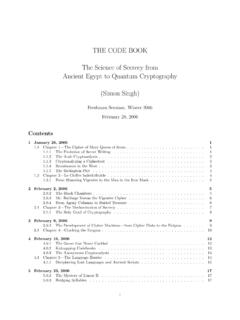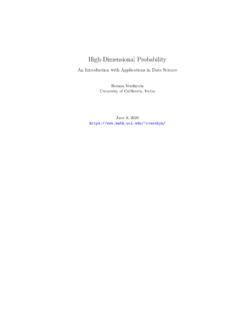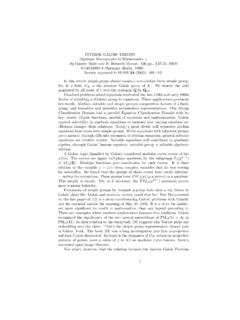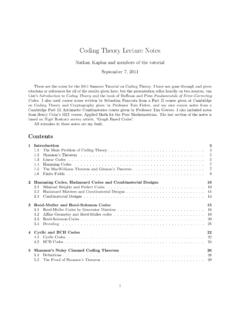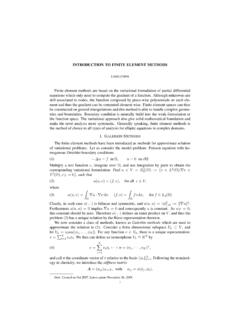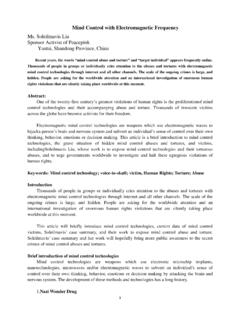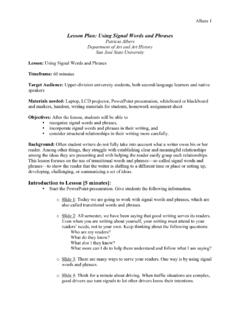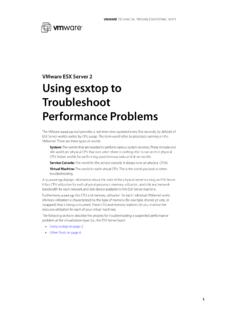Transcription of LaTeX Math Symbols - University of California, Irvine
1 3/29/17, 10*20 AMLaTeX Math SymbolsPage 1 of 9 ~cautis/ Math SymbolsThe following tables are extracted from The Not So Short Introduction to LaTeX2e, aka. LaTeX2e in 90 minutes, by Tobias Oetiker, HubertPartl, Irene Hyna, and Elisabeth Schlegl. It can be located , 10*20 AMLaTeX Math SymbolsPage 2 of 9 ~cautis/ , 10*20 AMLaTeX Math SymbolsPage 3 of 9 ~cautis/ , 10*20 AMLaTeX Math SymbolsPage 4 of 9 ~cautis/ , 10*20 AMLaTeX Math SymbolsPage 5 of 9 ~cautis/ , 10*20 AMLaTeX Math SymbolsPage 6 of 9 ~cautis/ , 10*20 AMLaTeX Math SymbolsPage 7 of 9 ~cautis/ , 10*20 AMLaTeX Math SymbolsPage 8 of 9 ~cautis/ , 10*20 AMLaTeX Math SymbolsPage 9 of 9 ~cautis/ modified: Wed May 31 14:04:55 CDT 2000XY-pic User s GuideKristo er H. Version , February 16, 1999 AbstractXY-pic is a package for typesetting graphs and diagramsusing Knuth s TEX typesetting system. XY-pic works withmost of the many formats available; , plain TEX, LaTeX , andAMS-TEX. Several styles of input for variousdiagram types are supported; they all share a mnemonicnotation based on thelogical composition of visual guide concentrates on how to typeset matrix-like diagrams, such as commutative diagrams,in the following style:Uy x%%(x,y)##X ZYq p//Xf Yg//Zwas typeset by the XY-pic input lines\xymatrix{U \ar@/_/[ddr]_y \ar@ \\& X \times_Z Y \ar[d]^q \ar[r]_p& X \ar[d]_f \\& Y \ar[r]^g & Z }Such diagrams have the following characteristics: Specified as a matrix of entries that are automati-cally aligned in rows and columns.
2 Any entry may be connected to any other en-try using a variety of arrow styles all rotated andstretched as required. Arrows may be decorated with labels that are tiedto a specified point along the arrow and extend ina particular direction; and arrows may be paired,cross, and visit/bend around other entries on theway. Several other styles of input are supported; a short surveyof the possibilities is included last at the end along withinformation on how XY-pic can be Loading .. Entries .. Arrows .. Labels .. Breaks .. Curving .. Speeding up typesetting .. 42 More Arrows and Explicit label positioning .. Labeling with any object .. More arrow styles .. Sliding arrows sideways .. More targets .. Changing the target .. Arrows passing under .. More bending arrows .. Defining new arrow types .. 83 More Manual entry formatting .. Extra entries outside the matrix .. Spacing and rotation.
3 Entry style .. Naming for later use as targets .. Grouping objects .. 104 Availability and Further Information Getting XY-pic .. Backwards compatibility .. Further reading .. Credits .. 13A Answers to all exercises13 References14 Index15 Laboratoire de l Informatique du Parall elisme, Ecole Normale Sup erieure de Lyon; 46, All ee d Italie; F 69364 Lyon 7, guide explains some features of XY-pic that arerelevant to typesetting of matrix-like diagrams asused in, for example, category theory; please refer tothe reference manual [8] for complete information onthe described constructions. The guide assumes thatyou have some experience in using TEX for typeset-ting mathematics, , have studied [2, ch. 16 19], [3,sec. ], or [9], and that XY-pic is installed on yourTEX system as described in theINSTALL file accom-panying the first section describes what you need to getstarted, in particular all that is needed to typesetthe diagram in the abstract.
4 Section 2 and 3 explainadvanced use of arrows and entries, respectively. Fi-nally, section 4 explains where and under what condi-tions XY-pic is available, gives the relation of to previous versions, and lists further sources we give exercises that you should beable to solve as you go along; all exercises are an-swered at the end just prior to the references BasicsThis section explains the XY-diagram constructionconcepts needed to get started with typesettingmatrix-like LoadingThe XY-pic setup used in this guide is loaded by in-serting the lines\input xy\xyoption{all}in the definitions part of your you wishto load only the features you use, or you wish to usenon-standard facilities like thev2backwards compat-ibility mode2or thepsPostScript3backend thenthis is also possible as described in the reference man-ual [8]. EntriesA diagram is created by the command\xymatrix{..}where the .. should be replaced byentriesto bealigned inrowsandcolumnswhere entries in a row are separated by&,4and entire rows are separated by\\.
5 For example,APmi=ni2 DccGGGGGGGGGwas typeset by\xymatrix{A &*+[F]{\sum_{i=n}^m {i^2}} \\& {\bullet} & D \ar[ul] }Notice the following: entries are typeset as mathematics ( using textstyle ); entries should not start with a macro(as illustrated by the use of{}around\bullet. all entries are centered and the separation be-tween rows and columns is usually quite largein a diagram, empty entries at the end of rows may be omit-ted, XY-decorations (here\ar[ul]) in entries al-low drawing of arrows and such relative to theentries without changing the overall layout, and XY-modifiers (here*+[F]) first in entries al-low changing the format and shape in ArrowsAn arrow in an XY-pic diagram is a generic termfor the drawn decorations between the entries of thebasic matrix structure. In XY-pic all arrows must bespecified along with the entry in which they start; thisis called theirbase entry. Each particular arrow com-mand then refers explicitly to itstarget entry. Thisis obtained using the\arcommand which acceptsmany options of which we will describe a few hereand some more in section 2.)
6 In its simplest form anarrow is entered as\ar[hop]wherehopis a sequenceof single letters:ufor up,dfor down,lfor left, andrfor right, , the arrow\ar[ur]reads typeset anarrow from the current entry to that one up and oneright. 1 LATEX2"[3] users can use\usepackage[all]{xy}.2If you use the version 2 loading command\input xypic(or thexypicdocument style option) then thev2option described insection will be loaded a registered Trademark of Adobe, Inc. [1].4 Thus when using XY-constructions involving&inside other tabular constructions then enclose the XY-pic construction in an extrapair of braces!2 Exercise 1:Which entry does[]refer to?The relative coordinates specified in this way arepurely logical, , if the diagram contains very wideentries then diagonal arrows will be nearly horizon-tal. The constructed arrows are aligned along the linebetween the centers of the base and target entries;they will not automatically disappear under entriesthat they cross (we discuss how this is achieved insection ).
7 The arrow style kan be changed by writing thecommand This will be describedin more detail in section ; here we just list the mostcommon@styles (obvious variations also work): ..@{=>} @{:>} V V V@{~>} @{-} @{}Exercise 2:Typeset @@@@@@@@@@@@@@ LabelsYou can put labels on arrows. Labels are conceptual-ized as sub- and superscripts on arrows such that theyare placed in the usual positions (as limits ), ,^reads above and_ below on an arrow pointingright. Notice that the positions dependonlyon thedirection of the arrow, the absolute notions of up, down, etc. are not important. For example,$\xymatrix@1{X\ar[r]^a_b & Y & Z\ar[l]^A_B }$will setXab//YZABoo(the@1is a special codethat can be used for one-line diagrams to improvethe placement on the line; more such spacing codesare described in section ).It is possible to use labels that are not single let-ters, digits, or control sequences: if a simple mathformula in the default style (script style) is desiredthen simply enclose in{.}
8 }. In practice anythingcan be used as a label as described in section label is placed perpendicular to the arrow atthe point halfway between the centers of the base andtarget objects. This is usually the most sthethic,however, in diagrams where the sizes of the entriesvary much it is sometimes nicer to place the labelat the center of the actual arrow. This behaviour isrequested by inserting a-(minus) right after the^or_:A B C D+//Bwas typeset by$\xymatrix@1{A\times B\times C\times D \ar[r]^-{+} &B}$(it becomesA B C D+//Bwithout the-).In fact-is in just one of the may possible placingsof labels described in section 3:Typeset the second axiom of categorytheory asAf//f;g @@@@@@@Bg g;h @@@@@@ BreaksIt is also possible to break an arrow with a label us-ing the|character:$\xymatrix@1{A\ar[r]|f&B}$ will you just want an empty break you shoulduse the special\holebreak: the arrowA//Bwas typeset by including$\xymatrix@1{A\ar[r]|\hole & B }$in the di erent use of breaks is to place a label some-where in a diagram outside the normal matrix mesh:this is accomplished by breaking an invisible arrowobtained using the@{}arrow style: the squareA= //B B//Cwas typeset by\xymatrix{\ar @{} [dr] |{=}A \ar[d] \ar[r] & B \ar[d] \\B \ar[r] & C }There is more on breaks in section 4:Typeset the first axiom of categorytheory as the displayAf f//BiB~~~~~~~~g CurvingArrows can be made to curve, for example to avoidgoing through another entry, using the special The simplest styles ofcurvingare thefollowing, shown applied to an arrow fromAtoB.
9 @/^/A))B@/_/A55B@/_1pc/A==BAs the last example shows a dimension can be in-serted just after^or_if more or less curving is case it is easier to specify the in- and out-goingdirections of the curving then that is also possible:use@(in,out)whereinandoutare one of the followingdirections:ONMLHIJKdl d dr???? r//ur ??uOOul????__looIn this case the curving is computed such that thecurve begins at the base entry in theindirectionand ends at the target entry from theoutdirection(this means that@(d1,d2)and@(d2,d1)are mirrorimages. See section for more directions).Exercise 5:Typesetxid99f,,f(x)f Speeding up typesettingOne thing that you will notice is that XY-pic is some-times slow in typesetting diagrams (this is to be ex-pected considering the number of drawing operationsperformed as reflected by the number last in eachxymatrixmessage). If you follow the rule of start-ing all entries with a (nonexpandable) character or{then you can insert the declaration\CompileMatricesin the preamble of your document: this will createtemporary files5containingcompiledversions of eachmatrix that can be loaded very quickly; they are au-tomatically recreated when a matrix is this causes some diagrams to not work, thensuch compilation can be explicitly switched o byusing\xymatrixnocompilein place of\ can be switched o completely with\NoCompileMatrices(which respects TEX groupingas does\CompileMatrices, by the way).}
10 And if you are still not satisfied with the speedthen you can add the following:\OnlyOutlineswhich will omit all compiled pictures; the additionalcommand\ShowOutlineswill add a dotted rectangleoutlining the size of the More Arrows and LabelsIn this section we explain a number of variations ofthe arrow commands that are useful in Explicit label positioningThe label commands explained in section placethe label text near the point along the arrow halfwaybetween the centers of the base and target , however, may be changed by inserting aplacebetween the^,_, or|, and the actual label (in fact-is aplace). In general you may insert the following: <will place the label at the point where theactual arrow begins, , appears from under the base, so$\xymatrix@1{A\ar[r]^<{+}&B}$will typesetA+//B. Similarly,>will place the label atthe point where the actual arrow ends, , disappears below the <<and>>will place the following la-bel at a point just a bit6further fromthe beginning and end of the using more<s or>s willmove the label further temporary files are named the same as your document replaced a sequence A bit is in fact a TEX\jotwhich is usually A factor in()s:(a)indicates that thelabel should be tied to the pointaofthe way from the center of the base en-try (called(0)) to the center of the tar-get (called(1)) instead of in the A factor can be givenaftersome<or>s, in which case the place is computedas if the base was specified by the<sand target specified by Finally, there is a simple way to denote theplace on an arrow where it intersects with astraight line between two points: the place!
